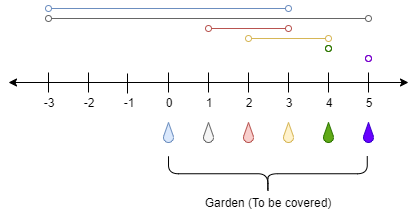- {x}
- Minimum Flips to Make a OR b Equal to c
- Number of Operations to Make Network Connected
- Minimum Distance to Type a Word Using Two Fingers
- Restaurant Growth
- Ads Performance
- Maximum 69 Number
- Print Words Vertically
- Delete Leaves With a Given Value
- Minimum Number of Taps to Open to Water a Garden
- List the Products Ordered in a Period
- Break a Palindrome
- Sort the Matrix Diagonally
- Reverse Subarray To Maximize Array Value
- Rank Transform of an Array
- Remove Palindromic Subsequences
- Filter Restaurants by Vegan-Friendly, Price and Distance
- Find the City With the Smallest Number of Neighbors at a Threshold Distance
- Read More...

Minimum Number of Taps to Open to Water a Garden
There is a one-dimensional garden on the x-axis. The garden starts at the point 0 and ends at the point n. (i.e., the length of the garden is n).
There are n + 1 taps located at points [0, 1, ..., n] in the garden.
Given an integer n and an integer array ranges of length n + 1 where ranges[i] (0-indexed) means the i-th tap can water the area [i - ranges[i], i + ranges[i]] if it was open.
Return the minimum number of taps that should be open to water the whole garden, If the garden cannot be watered return -1.
Example 1:

Input: n = 5, ranges = [3,4,1,1,0,0] Output: 1 Explanation: The tap at point 0 can cover the interval [-3,3] The tap at point 1 can cover the interval [-3,5] The tap at point 2 can cover the interval [1,3] The tap at point 3 can cover the interval [2,4] The tap at point 4 can cover the interval [4,4] The tap at point 5 can cover the interval [5,5] Opening Only the second tap will water the whole garden [0,5]
Example 2:
Input: n = 3, ranges = [0,0,0,0] Output: -1 Explanation: Even if you activate all the four taps you cannot water the whole garden.
Constraints:
1 <= n <= 104ranges.length == n + 10 <= ranges[i] <= 100
1326. Minimum Number of Taps to Open to Water a Garden
Problem Description
Given a garden of length n and an array ranges where ranges[i] represents the range of the i-th tap, find the minimum number of taps needed to water the entire garden. Each tap at index i can water the interval [i - ranges[i], i + ranges[i]]. If it's impossible to water the entire garden, return -1.
Solution: Greedy Approach
The optimal solution involves a greedy strategy. We prioritize taps that cover the most ground. The algorithm works as follows:
-
Preprocessing: Create an array
lastwherelast[i]stores the farthest right endpoint reachable starting from positioni. This is done by iterating through therangesarray and updatinglastaccordingly. For each tap, we calculate its left and right coverage and updatelastto record the maximum right reach starting from that left point. -
Greedy Iteration: We iterate from left to right through the garden (0 to n). We maintain:
ans: The count of taps used.mx: The farthest right point currently reachable.pre: The farthest right point reached by the previously used tap.
-
Iteration Logic:
- In each iteration,
mxis updated to the maximum reachable point from the current position (i). - If
mxis less than or equal toi, it means we're stuck and cannot reach further; thus, the garden cannot be fully watered, so we return -1. - If
preequalsi, this means we need to use a new tap to extend our reach. We incrementansand updatepreto the new maximum reachable point (mx).
- In each iteration,
-
Return Value: After the loop completes,
ansrepresents the minimum number of taps required.
Time and Space Complexity
- Time Complexity: O(n), where n is the length of the garden. The preprocessing and iteration both take linear time.
- Space Complexity: O(n) to store the
lastarray.
Code Implementation (Python)
class Solution:
def minTaps(self, n: int, ranges: List[int]) -> int:
last = [0] * (n + 1)
for i, x in enumerate(ranges):
l, r = max(0, i - x), i + x # Calculate left and right coverage
last[l] = max(last[l], r) # Update last[l] with max reach from l
ans = mx = pre = 0
for i in range(n):
mx = max(mx, last[i]) # Update max reach
if mx <= i: return -1 # Cannot proceed further
if pre == i: # Need a new tap
ans += 1
pre = mx # Update previous reach
return ansNote: The code in other languages (Java, C++, Go, TypeScript, Rust) provided in the original response follows the same algorithm with minor syntactic variations for each language. The core logic remains consistent across all implementations.